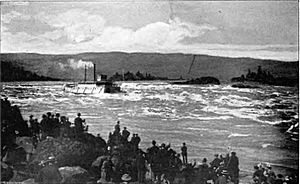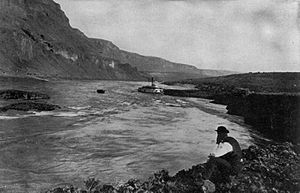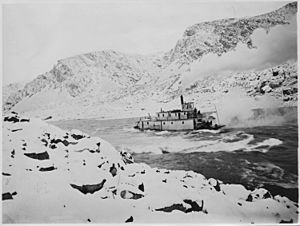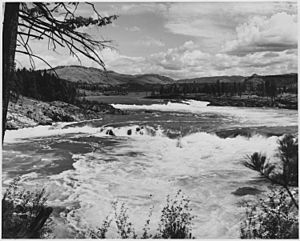List of rapids of the Columbia River facts for kids
The Columbia River is a long and powerful river that flows through both Canada and the United States. Along its path, it used to have many exciting and sometimes dangerous sections called rapids. Rapids are parts of a river where the water flows very fast over rocks, making it bumpy and exciting! Today, most of these rapids are hidden underwater because of big dams built along the river. This article tells you about some of the most famous rapids, listed from the mouth of the river all the way upstream.
Contents
Rapids from the Mouth to the Snake River
The Cascade Rapids were also known as The Cascades or Grand Rapids. They were located near where the Bonneville Dam is today, in the beautiful Columbia River Gorge. The river here dropped about 40 feet (12 m) over approximately 2 miles (3.2 km)! This made the water rush through a narrow channel, only about 150 yards (140 m) wide. In 1937, these rapids disappeared when the Lake Bonneville reservoir was created by the Bonneville Dam.
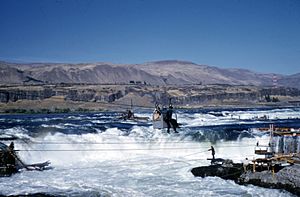
- Celilo Falls and The Dalles
This was a series of rapids and falls with many names, like The Chutes or Great Falls of the Columbia. They were located near The Dalles, Oregon. Over about 12 miles (19 km), the river dropped an amazing 81 feet (25 m)! In some spots, the channel became super narrow, only 75 feet (23 m) wide. This series included smaller rapids like Threemile Rapids, The Dalles Rapids, Fivemile Rapids, Tenmile Rapids, and the famous Celilo Falls. Most of these rapids were covered by water in 1957 when The Dalles Dam created Lake Celilo. Threemile Rapids is still just below the dam.
- Preachers Eddy
This rapid was located near Rufus, Oregon.
- Schofield Rapids
This was a small rapid located just below where the John Day Dam is now. It wasn't very dangerous. In 1957, it was covered by the waters of Lake Celilo, the reservoir of The Dalles Dam.
- John Day Rapids
These rapids were located near the mouth of the John Day River. There were two main parts: the Lower John Day Rapids and the Upper John Day Rapids. The Army Corps of Engineers, a group that helps manage rivers, worked to make it easier for boats to pass here. For example, in 1911, they removed a "large reef" (a rocky area) from the middle. These rapids were submerged in 1971 when the John Day Dam created Lake Umatilla.
- Indian Rapids
This small rapid was located just above the mouth of the John Day River. It wasn't considered very dangerous. When explorer David Thompson visited in 1811, he called it Muscle Rapids because he found many shells there. Like the John Day Rapids, it was covered by Lake Umatilla in 1971.
- Squally Hook Rapids
Located a few miles above the John Day River, this rapid was not a major danger, though one person called it "short sharp and savage." In 1912, the Army Corps of Engineers improved it by blasting away rocks. It was submerged in 1971 by Lake Umatilla.
- Rock Creek Rapids
These rapids were near the mouth of Rock Creek. They were described as "rough and rowdy" but not extremely dangerous.
- Blalock Rapids
This was a very small rapid. It was submerged in 1971 by Lake Umatilla.
- Owyhee Rapids
Another very small rapid, located near Arlington, Oregon. It was also submerged in 1971 by Lake Umatilla.
- Canoe Encampment Rapids
This was a minor rapid located about 3 miles (4.8 km) below Boardman, Oregon. In 1912, the Army Corps of Engineers made it safer for boats by removing large rocky areas from the middle of the river, which were dangerous when the water was low. These rapids were submerged in 1971 by Lake Umatilla.
- Umatilla Rapids
The Umatilla Rapids were a very important and challenging rapid, located where McNary Dam is today. They were over 1.5 miles (2.4 km) long. During low water times (like November to March), these rapids made it very hard for steamboats to travel further upstream. Larger boats sometimes couldn't even reach these rapids! When the water was high, big boats could travel much further up the river. To help navigation, rocks were blasted in 1891 to create a path for steamboats. More work was done in 1910 and 1911. In 1805, the famous Lewis and Clark Expedition called them Musselshell Rapids because of all the mussels they found. These rapids were submerged in 1954 when McNary Dam created Lake Wallula. Parts of the dam were even built on top of the lower rapids.
- Homley Rapids
This was a very small rapid located about 7 miles (11 km) below Pasco, Washington. In 1911, the Army Corps of Engineers said it was the shallowest spot on the Columbia between Celilo and the Snake River. They worked to clear the main channel and build "wing dams" to push more water into it. These rapids were submerged in 1954 by Lake Wallula.
- Bull Run Rapids
A very small rapid located a few miles below Wallula Gap.
Rapids from the Snake River to Bridgeport
The 70-mile stretch of the river between Priest Rapids and the Snake River (called the Hanford Reach) has the slowest current of any part of the Columbia above The Dalles.
- Coyote Rapids
This is a minor rapid located next to the "100 Area" of the Hanford Site, which is known for its old nuclear reactors. Unlike many other rapids, Coyote Rapids still exist today as part of the Hanford Reach of the Columbia River.
Priest Rapids was a series of seven rapids located near Mattawa and Desert Aire. The river dropped 72 feet (22 m) over its 9 miles (14 km) length, with a big drop of 20 feet (6.1 m) in just one short section! In 1888, two steamboats were built specifically to try and get through Priest Rapids and Rock Island Rapids. The first one failed, but the second, smaller boat, the City of Ellensburg, successfully passed through both. Later, another boat, the Thomas L. Nixon, also made it. In 1959, these rapids were submerged under Priest Rapids Lake, the reservoir of Priest Rapids Dam.
- Cabinet Rapids
These rapids were located at the mouth of Moses Coulee. The river dropped about 10 feet (3.0 m) over a long stretch of about 8,000 feet (2,400 m). In 1963, the rapids were submerged under Lake Wanapum, the reservoir of Wanapum Dam.
- Nixon Rapids
Located a few miles below Rock Island Dam, these rapids are now submerged in Lake Wanapum, the reservoir of Wanapum Dam.
- Rock Island Rapids
These rapids were located near Rock Island Dam and Rock Island. They were over 2 miles (3.2 km) long! Local Native American people called them Squah-ah-shee. The name "Rock Island" came from a large rock in the river. The channels around this island were full of rocks, making it very difficult for boats. The river dropped 10 feet (3.0 m) over 3,000 feet (910 m) when the water was low. In 1933, these rapids were submerged in Rock Island Pool, the reservoir of Rock Island Dam. At least two steamboats were wrecked here, including the Selkirk in 1906. Like Priest Rapids, special steamboats were built in 1888 to try and navigate these tough rapids, and some eventually succeeded.
- Entiat Rapids
These rapids were located between the mouth of the Entiat River and Orondo. They are now submerged in Lake Entiat, the reservoir of Rocky Reach Dam.
- Methow Rapids
Located at the mouth of the Methow River near Pateros. In 1967, these rapids were submerged in Lake Pateros, the reservoir of Wells Dam.
Rapids from Bridgeport to the Canada–US Border
The part of the river between Monaghan Rapids and Foster Creek Rapids was known as being very dangerous. An 1893 report said this section was "very swift and studded with rocks" and "extremely hard and dangerous if not absolutely impassable" for boats. Over 45 miles (72 km), the river dropped 171 feet (52 m) when the water was low. The section from White Cap Rapids to Eagle Rapids was once called "Nespilem Canyon." The 1893 report said that in the worst 3 miles (4.8 km) stretch, the river dropped 22 feet (6.7 m) at low water, and the current could be as fast as 10 miles per hour (16 km/h)! It was thought that no amount of rock removal could make this part of the river safe for boats.
- Reef Rapids
Located between Bridgeport and Chief Joseph Dam. It was submerged in 1967 by Lake Pateros, the reservoir of Wells Dam.
- Foster Creek Rapids
Located just above Chief Joseph Dam and Bridgeport. These rapids were about a mile long and are now submerged in Rufus Woods Lake, the reservoir of Chief Joseph Dam. An 1893 report called them "among the worst rapids on the river." In 1911 and 1912, the Army Corps of Engineers tried to improve navigation by blasting submerged rocks from Reef Rapids all the way up to Eagle Rapids.
- Eagle Rapids
Also called Whirlpool Rapids or Kalichen Falls. Located just below Box Canyon. These rapids are now submerged in Rufus Woods Lake, the reservoir of Chief Joseph Dam.
- Long Rapids
Located just above Box Canyon. These rapids are now submerged in Rufus Woods Lake, the reservoir of Chief Joseph Dam.
- White Cap Rapids
Located between Gaviota Bend and Box Canyon. These rapids are now submerged in Rufus Woods Lake, the reservoir of Chief Joseph Dam. An explorer named Lewis R. Freeman described White Cap Rapids as a narrow, straight, and steep channel "heavily littered with boulders" with "mad tumble of wallowing waters."
- Parson Rapids
Located at Tombstone Rocks, a few miles below Goose Flats. These rapids are now submerged in Rufus Woods Lake, the reservoir of Chief Joseph Dam.
- Granite Rapids
Located south of Saddle Horse Flat. These rapids are now submerged in Rufus Woods Lake, the reservoir of Chief Joseph Dam.
- Mah-kin Rapids
Also called Mahkin. Located at the head of Nespelem Canyon. These rapids are now submerged in Rufus Woods Lake, the reservoir of Chief Joseph Dam.
- Nespelem Rapids
Located just above the mouth of the Nespelem River. These rapids are now submerged in Rufus Woods Lake, the reservoir of Chief Joseph Dam.
- Equilibrium Rapids
Also called Jumbo Rapids. Located at Bailey Basin. These rapids are now submerged in Rufus Woods Lake, the reservoir of Chief Joseph Dam. The name "equilibrium" was given because there was a rock in the rapids that rolled back and forth in the strong current.
- Monaghan Rapids
Also called Moneghan's Rapids or Buckley's Rapids. Located just below an island called Buckley Bar. The name was given in 1881 to honor James Monaghan, who had trouble bringing supplies downriver on rafts in 1879-1880. These rapids are now submerged in Rufus Woods Lake, the reservoir of Chief Joseph Dam.
- Hell Gate
This was a gorge and rapids located about 23 miles (37 km) upstream of Grand Coulee Dam. Hellgate Island is located in Hell Gate Canyon. These rapids were submerged in 1942 when Grand Coulee Dam created Franklin D. Roosevelt Lake.
- Spokane Rapids
Located at the mouth of the Spokane River. These rapids were submerged in 1942 by Franklin D. Roosevelt Lake.
- Turtle Rapids
A minor rapid located near Bissell. The name comes from several rock outcrops that looked like turtle backs.
- Rickey Rapids
Also called Grand Rapids. These were fairly dangerous rapids located about 3 miles (4.8 km) south of the Colville River and Kettle Falls. They were so dangerous that even small boats usually had to be carried around them (portaged). In 1826, explorer David Douglas named them "Thompson Rapids." The name "Rickey" came from John Rickey, who had a store nearby. Today, these rapids are submerged in Franklin D. Roosevelt Lake.
Located about two miles below the mouth of the Kettle River and five miles above the mouth of the Colville River, near the city of Kettle Falls. These famous falls are now submerged in Franklin D. Roosevelt Lake, the reservoir of Grand Coulee Dam.
- Little Dalles
Located six miles downriver of Northport. The river narrowed to 130 feet (40 m) here. While not too hard to navigate at low water, during high water, the river dropped 20 feet (6.1 m), making it very dangerous. The Little Dalles was the main obstacle for boats trying to go further upriver into Canada. The river was squeezed between huge stone cliffs. An 1893 report described it as "placid" at low water but "a seething, whirling torrent" at high water. It was said that "Trees and logs 60 or 70 feet in length disappear in Little Dalles at high water; they go right down on end and do not reappear." These rapids were submerged in 1942 by Franklin D. Roosevelt Lake.
- Pingstone Rapids
Located about 9 miles (14 km) above the mouth of the Kettle River. These rapids are now submerged in Franklin D. Roosevelt Lake.
Rapids from the Canada–US Border to Revelstoke
- Waterloo Eddy
This was a whirlpool located at the mouth of Cai Creek, near Waterloo Road.
- Kootenay Rapids
Formerly called Tincup Rapids. This was a minor rapid located just below the mouth of the Kootenay River, near Castlegar. It was about 0.25 miles (0.40 km) long and not very strong.
- Tincup Rapids
Formerly called Kootenay Rapids. These were a pair of rapids, called Upper and Lower Tincup Rapids, located at Castlegar, just above the mouth of the Kootenay River. The river narrowed to 201 metres (659 ft) here. For steamboats, these rapids were a problem during low water in autumn and winter. In the 1890s, people tried to improve the channel by blasting rocks. Explorer David Thompson noted them as a "strong rapid" in 1811. The names of Tincup and Kootenay Rapids were actually swapped sometime before 1916!
- The Narrows
This was a section between Upper Arrow Lake and Lower Arrow Lake where the Columbia's water flowed swiftly for about 14 miles (23 km). The name of the lakes comes from "Arrow Rock," a tall rock along The Narrows. After the Hugh Keenleyside Dam was built in 1968, the two Arrow Lakes joined together, and The Narrows were submerged.
Rapids from Revelstoke to Mica Dam
- Big Eddy
This was a whirlpool located at a sharp bend in the river just above downtown Revelstoke. The area of Revelstoke was first known as "The Eddy" because of this large swirl in the river.
- Steamboat Rapids
Located just north of downtown Revelstoke, about 4 kilometres (2.5 mi) below Revelstoke Dam.
- Little Dalles Canyon
Located just north of Revelstoke. The Revelstoke Dam and the southern end of its reservoir, Lake Revelstoke, are in this canyon. The word "dalles" means rapids.
- Eighteen Mile Rapids
Located near the mouth of Park Creek. These rapids were submerged by Lake Revelstoke.
- Priest Rapids
Located just south of Dalles des Morts and about 5 kilometres (3.1 mi) north of the mouth of Downie Creek. These rapids were submerged in Lake Revelstoke in 1984. The name comes from two French-Canadian priests who drowned here. Priest Rapids was known as the fastest rapids on the Columbia River, with a current said to be over 20 miles per hour (32 km/h)!
- Dalles des Morts (Death Rapids)
This was one of the most dangerous rapids on the Columbia River, located just above Priest Rapids. The name dates back to 1817 when seven voyageurs (travelers) wrecked here and tried to walk over 300 miles (480 km) to Spokane House, but only one survived. Many other fatal accidents happened here, including twelve people drowning in 1838. Today, these rapids are submerged in Lake Revelstoke, the reservoir of Revelstoke Dam.
- Rock Slide Rapids
Located about 1 mile (1.6 km) downriver of Twelve Mile Rapids. Explorer Lewis Freeman described Rock Slide Rapids as the narrowest point of the entire Columbia River below Windermere Lake, with the channel only about 70 feet (21 m) wide. The river rushed through this narrow spot into a "cauldron-like eddy" and then into another narrow chute to form the Dalles des Morts. Today, these rapids are submerged in Lake Revelstoke.
- Twelve Mile Rapids
Located just upriver of Dalles des Morts. These rapids were submerged by Lake Revelstoke.
- Gordon Rapids
Located at the mouth of Ruddock Creek, about 10 kilometres (6.2 mi) above the mouth of the Goldstream River, and about 40 kilometres (25 mi) below Mica Dam. These rapids were submerged by Lake Revelstoke.
Rapids from Mica Dam to the Source at Columbia Lake
- Twenty-One-Mile Rapids
Explorer Lewis Freeman used this name for a long series of rapids, about 21 miles (34 km) long, between the outlet of Kinbasket Lake and the mouth of the Canoe River. This series included Redrock Canyon Rapids, Yellow Creek Rapids, Weasel Rapids, Mink Rapids, and Boulder Rapids. Freeman thought it might be one of the longest continuous stretches of rapids in the world! For the first 16 miles (26 km), one rapid flowed right into the next. The last 5 miles (8.0 km) had less white water but still a very fast current with many swirls. The river was tightly squeezed by canyons, so travelers had to go through the whole series in one day. Freeman also reported a new, powerful rapid that appeared after a large landslide.
- Redrock Canyon Rapids
Located near Redrock Harbour, about 5 kilometres (3.1 mi) downriver from Yellow Creek, and approximately 10 kilometres (6.2 mi) upriver from Mica Dam. These rapids are now submerged in Kinbasket Lake.
- Yellow Creek Rapids
Located near Yellow Bay, about 15 kilometres (9.3 mi) upriver from Mica Dam. These rapids are now submerged in Kinbasket Lake.
- Weasel Rapids
Located just south of the mouth of Yellow Creek, approximately 20 kilometres (12 mi) upriver from Mica Dam. These rapids are now submerged in Kinbasket Lake.
- Mink Rapids
Located near the mouth of Three Minute Creek, about 25 kilometres (16 mi) upriver from Mica Dam. These rapids are now submerged in Kinbasket Lake.
- Boulder Rapids
Located about 3 kilometres (1.9 mi) above the Cummins River and approximately 25 kilometres (16 mi) upriver from Mica Dam. These rapids are now submerged in Kinbasket Lake.
- Surprise Rapids
Located just northwest of the Bush River, about 70 kilometres (43 mi) upriver from Mica Dam. The river here dropped about 100 feet (30 m) over approximately 3.33 miles (5.36 km). There were at least three cascades (small waterfalls) within this length. The first cascade was the biggest, dropping 21 feet (6.4 m). In 1973, these rapids were submerged in Kinbasket Lake, the reservoir of Mica Dam.
- Brinkmans Terror Rapids
Located at the mouth of the Beaver River, approximately 16 kilometres (9.9 mi) downriver from Donald, British Columbia. These rapids are now submerged in the Columbia Reach of Kinbasket Lake.
- Kitchins Rapids
Located at the upper end of Kinbasket Lake, near Redgrave. These rapids are now submerged in the Columbia Reach of Kinbasket Lake.
See also
- Baillie-Grohman Canal
- Steamboats of the Arrow Lakes
- Steamboats of the Columbia River
- Steamboats of the Columbia River, Wenatchee Reach
- Shipwrecks of the inland Columbia River
- York Factory Express



